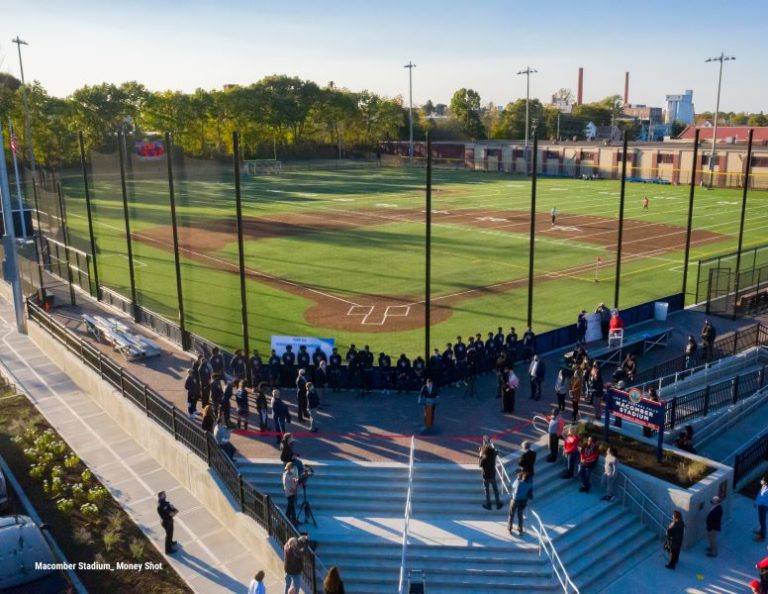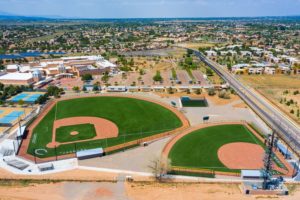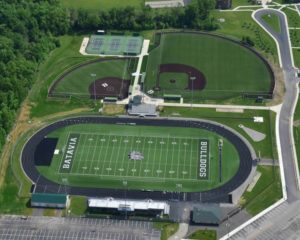By Mary Helen Sprecher
Before players take the field. Before the first pitch is thrown. Before the crack of a bat (or the swish of a strike) sends spectators into a frenzy and declares the season open – before all that happens, comes the golden window of opportunity for making baseball facilities the best they can be.
You already know facilities can have surfaces that are natural or manmade; however, one essential point is that both require regular upkeep, and that starts with walking the fields regularly to look for problem areas. On natural fields, keep an eye out for rutted, worn or wet areas, signs of disease or pest infestation, as well as any areas where weeds are encroaching. On synthetic fields, some symptoms to look for low or wet spots, as well as issues of wear or damage to the turf.
And care shouldn’t just come during the playing season, or even the preseason. According to Lee Narozanick, CFB, CTB, of American Athletic Track and Turf, a program of maintenance should go on throughout the year – with the possible exception of times when fields are snow-covered and can’t be used. (In which case, it’s a suitable time to make sure all maintenance equipment is in good working order, and to make repairs as necessary.)
“In the offseason, care should still be given to the fields,” said Narozanick. “This way, the work is minimized in the spring to ready the field for play, rather than having a heavy maintenance load.”
“How often you do regular maintenance depends mainly on how often a field is used,” said Todd Smith, Ph.D., PE, LEED AP of R&R Engineers-Surveyors, Inc. “It’s pretty common to have the baseball team arrive early by an hour or two or stay late” [thus adding time the field is in use, beyond actual game hours].
Work that should be undertaken includes raking of the entire area, rebuilding the pitcher’s mound, rebuilding the batter’s box, and chalking the batter’s box along with foul lines, he said. Smith cautions against falling prey to a few common mistakes in maintenance.
“For the infields, the main mistake is not doing a little maintenance each day or each time the field is used. The second-most often made mistake, in my experience, is always dragging from the center in a spiral to the outside to avoid equipment tracks if they end in the center. This is the number-one cause of what is called the “infield lip,” which is when the infield mix is deposited into the first two to three feet of the outfield edge. This raises the rootzone and the grass grows through it. Then it gets raised again, the grass goes through it again – and suddenly the infield lip causes a ball rolling to the outfield to hop up into a fielder’s chin instead of rolling true.”
In terms of common mistakes, he adds, “For me, it’s the same two main answers as the Sports Field Management Association (SFMA) has been giving for 20 years. The first big mistake is overwatering. Just because a grass blade turns a bit tan or brown doesn’t mean it needs more water. It may need rest, as every living organism does. It may need more phosphorus and potassium fertilizer to help store energy reserves. It may be out of its temperature range. In the Southwest, for example, people overwater their yards all July and August because their bluegrass turns a bit brown – but it is turning brown because the summers are too hot for bluegrass, and it is going dormant as a result of the temperatures. The second mistake is using too much nitrogen. Again, just because the grass is browning doesn’t mean it needs nitrogen; if you add too much, it might look nice and green, but it has lower root strength and no reserves so it can’t handle as much use.”
If your field is made of synthetic turf, it too should get regular care, commensurate to its use.
“Maintaining the field should match the amount of use the field gets,” said Mitchell Truban of Tarkett Sports/Beynon. “If it’s a high-use field, the sweeping, grooming and deep cleaning will happen more often than one that is used a couple times a month. The high-use areas (batter’s box, pitcher’s mound, slide areas, etc.) should be groomed and infill monitored after each use.”
Narozanick added that synthetic turf fields should be visually inspected weekly, so as to nip problems in the bud. “Groom it at least every two weeks with a soft-tined tool and keep the turf clean.”
Another good baseline for maintenance work is to figure out how many hours the field is in use, and schedule upkeep around that, said Robert Cohen, CSI, CDT, of Robert J. Cohen Co. LLC/Sport Surfaces Distributing, Inc. “Groom the field every 40 hours of use and sweep as needed,” he said.
If a high-wear area, such as the pitcher’s mound, needs to be replaced on a synthetic field, it will be necessary to take the level of play into consideration, as pitching distances and mound heights vary according to the age of the player.
According to David Moxley of Sportsfield Specialties, it is possible to purchase pitching mound forming systems designed specifically for synthetic turf facilities.
“Look for a product that allows the height of the mound to be tailored to the exact specifications needed for the play you’ll be hosting,” he said.
Many schools, sports parks and other entities have plans – even if they’re still on the proverbial drawing board – for one or more additional fields. In these cases, there’s still plenty of decision making involved. For those who would like to become more knowledgeable about their options, the American Sports Builders Association publishes Sports Fields: A Construction and Maintenance Manual. The book walks readers through the decision-making process that should precede deciding upon a field surface, as well as its location. It also discusses various types of field surfaces. The book is available in both hard copy and electronic form from the ASBA website, www.sportsbuilders.org.
Mary Helen Sprecher wrote this article on behalf of the American Sports Builders Association (www.sportsbuilders.org), the national organization for builders, design professionals and suppliers of materials for sports fields, running tracks, tennis courts and indoor and outdoor courts and recreational facilities.




